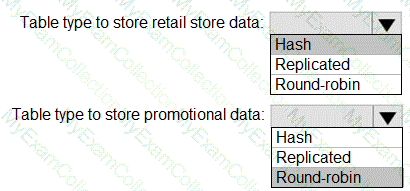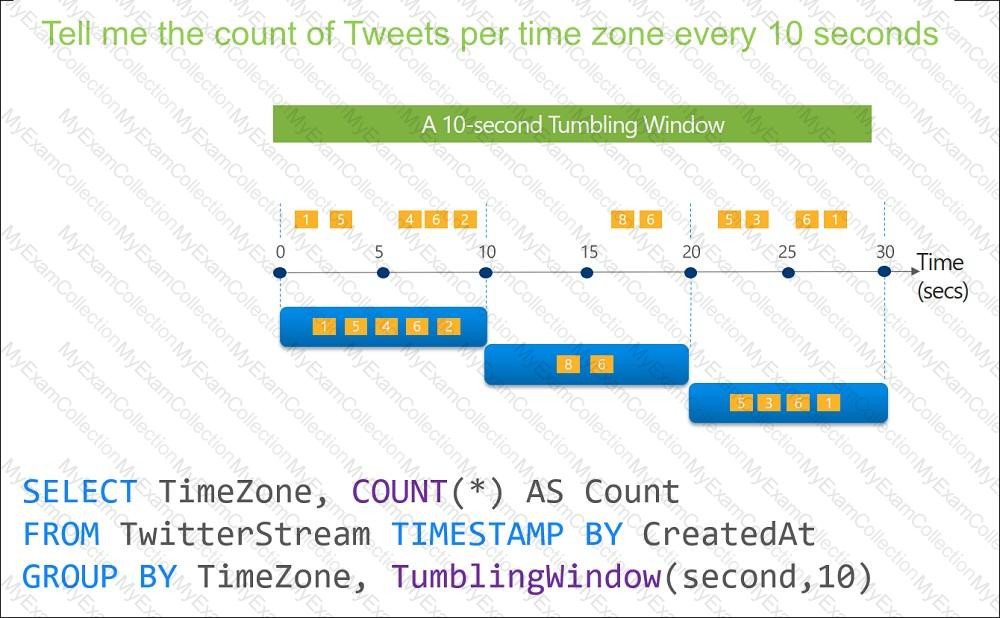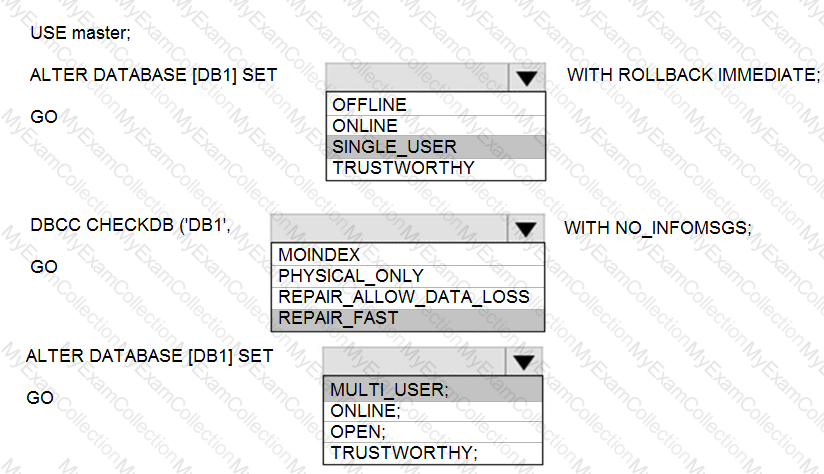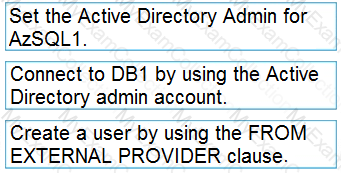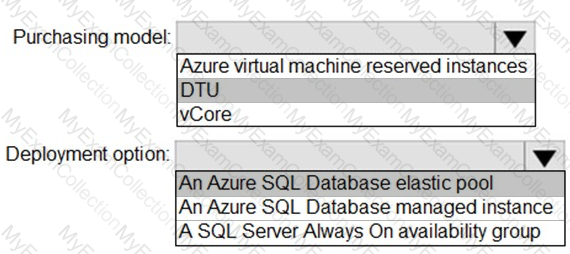You need to provide an implementation plan to configure data retention for ResearchDB1. The solution must meet the security and compliance requirements.
What should you include in the plan?
You need to design an analytical storage solution for the transactional data. The solution must meet the sales transaction dataset requirements.
What should you include in the solution? To answer, select the appropriate options in the answer area.
NOTE: Each correct selection is worth one point.
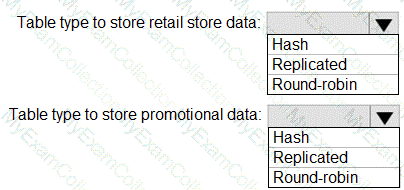
You need to implement the surrogate key for the retail store table. The solution must meet the sales transaction dataset requirements.
What should you create?
Based on the PaaS prototype, which Azure SQL Database compute tier should you use?
You need to design a data retention solution for the Twitter feed data records. The solution must meet the customer sentiment analytics requirements.
Which Azure Storage functionality should you include in the solution?
What should you implement to meet the disaster recovery requirements for the PaaS solution?
You need to implement a solution to notify the administrators. The solution must meet the monitoring requirements.
What should you do?
Which audit log destination should you use to meet the monitoring requirements?
You are evaluating the role assignments.
For each of the following statements, select Yes if the statement is true. Otherwise, select No.
NOTE: Each correct selection is worth one point.
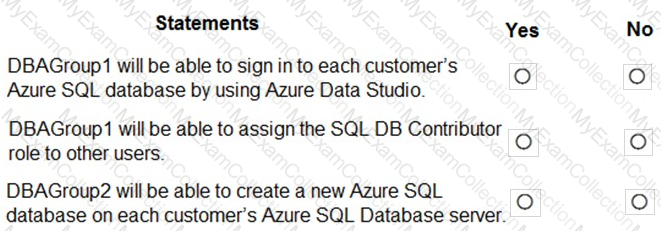
Task 9
You need to generate an email alert to admin@contoso.com when CPU percentage utilization for db1 is higher than average.
Task 6
You need to ensure that any enhancements made to the Query Optimizer through patches are available to dbl and db2 on sql37006895.
You need to identify the event_file target for monitonng DB3 after the migration to Azure SQL Database. The solution must meet the management requirements.
What should you use as the event_file target?
You need to recommend a process to automate the management of DB3. The solution must meet the management requirements. What should be the first step of the process?
You need to identify the event_flle target for monitonng DB3 after the migration to Azure SQL Database. The solution must meet the management requirements,
What should you use as the event_file target?
You need to recommend a solution to meet the security requirements and the business requirements for DB3. What should you recommend as the first step of the solution?
Task 1
In an Azure SQL database named db1, you need to enable page compression on the PK_SalesOrderHeader_SalesOrderlD clustered index of the SalesLT.SalesOrderHeader table.
You need to recommend a backup solution to restore DB3. The solution must meet the availability requirements. Which type of backup should you use?
Which counter should you monitor for real-time processing to meet the technical requirements?
You need to recommend a solution to ensure that the performance of DB3 is optimized after the migration to Azure SQL Database. The solution must meet availability requirements.
What should you include in the recommendation?
You need to recommend a service tier and a method to offload analytical workloads for the databases migrated from SVR1. The solution must meet the availability and business requirements.
What should you recommend? To answer, select the appropriate options in the answer area.
NOTE: Each correct selection is worth one point.
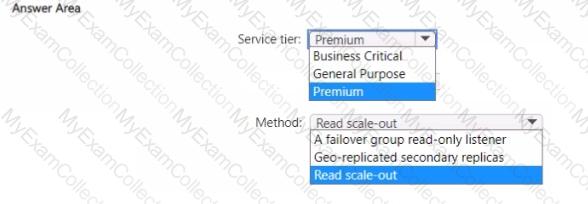
You plan to deploy Instance1 by using the following script.
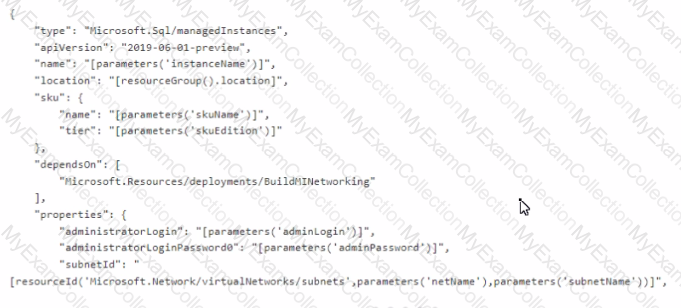
You need to specify the licenseType and storagenedundancy parameters. The deployment must meet the availability requirements and the business requirements for DB1 and DB2.
To what should you set each parameter? To answer, select the appropriate options in the answer area.
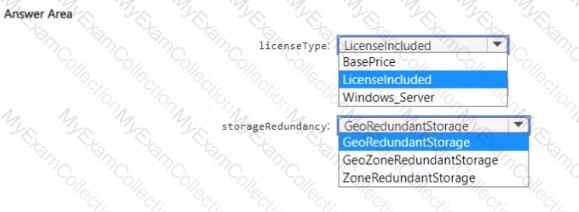
You need to recommend which configuration to perform twice to enable access to the primary and secondary replicas of DB3. The solution must meet the availability requirements.
What should you recommend?
You need to recommend a solution that will enable remote developers to access DB1 and DB2. The solution must support the planned changes and meet the secunty requirements.
What should you include in the recommendation?
Which windowing function should you use to perform the streaming aggregation of the sales data?
You need to recommend an authentication solution for App1 access to DB1 and DB2 after their migration to Instance1. The solution must meet the availability requirements.
Which actions should you perform in sequence? To answer, drag the appropriate actions to the correct order. Each action may be used once, more than once, or not at all. You may need to drag the split bar between panes or scroll to view content.
NOTE: Each correct selection is worth one point.

You have an Azure subscription that contains an Azure SQL managed instance named SQLMi1 and a SQL Agent job named Backupdb. Backupdb performs a daily backup of the databases hosted on SQLMi1.
You need to be notified by email if the job fails.
Which three actions should you perform in sequence? To answer, move the appropriate actions from the list of actions to the answer area and arrange them in the correct order.
NOTE: More than one order of answer choices is correct. You will receive credit for any of the correct orders you select.
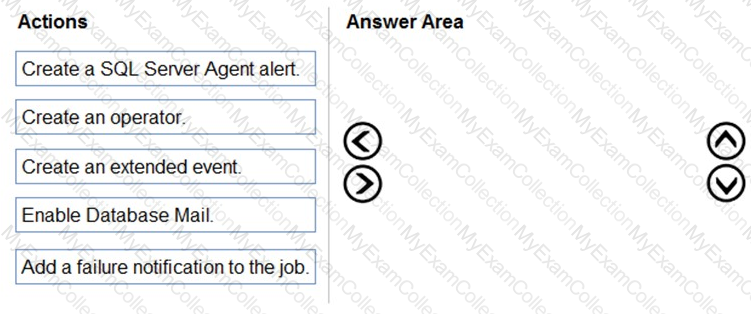
You need to recommend which service and target endpoint to use when migrating the databases from SVR1 to Instance1. The solution must meet the availability requirements.
What should you recommend? To answer, select the appropriate options in the answer area.
NOTE Each correct selection is worth one point.
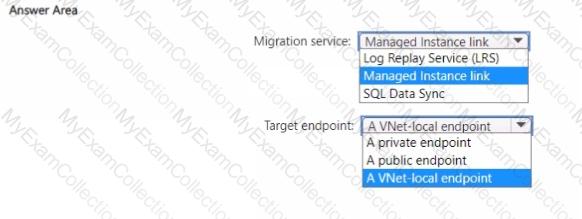
You have an Azure SQL database.
You discover that the plan cache is full of compiled plans that were used only once.
You run the select * from sys.database_scoped_configurations Transact-SQL command and receive the results shown in the following table.

You need relieve the memory pressure.
What should you configure?
You have SQL Server on an Azure virtual machine that contains a database named DB1.
The database reports a CHECKSUM error.
You need to recover the database.
How should you complete the statements? To answer, select the appropriate options in the answer area.
NOTE: Each correct selection is worth one point.
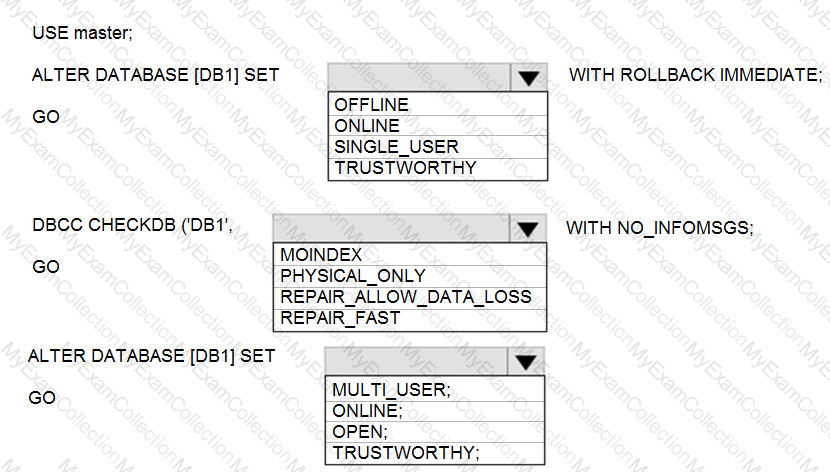
You have an Azure subscription.
You plan to deploy an Azure SQL database by using an Azure Resource Manager template.
How should you complete the template? To answer, select the appropriate options in the answer area.
NOTE: Each correct selection is worth one point.
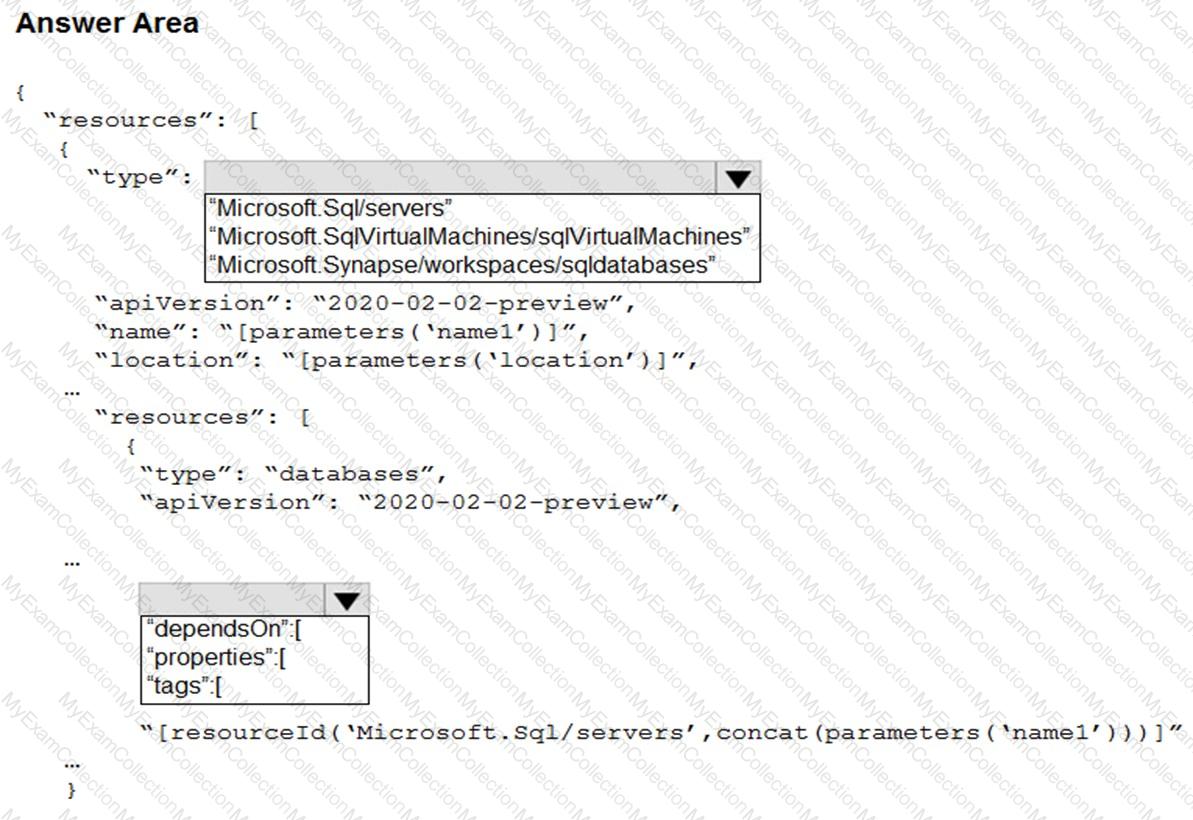
You plan to deploy an Always On failover cluster instance (FCI) on Azure virtual machines.
You need to provision an Azure Storage account to host a cloud witness for the deployment.
How should you configure the storage account? To answer, select the appropriate options in the answer area.
NOTE: Each correct selection is worth one point.

You have an instance of SQL Server on Azure Virtual Machines named VM1.
You need to implement a disaster recovery solution that meets the following requirements:
• Returns the solution to an operational state within 15 minutes of a failure
• Can perform disaster recovery testing in an isolated environment
• Minimizes administrative effort
What should you include in the solution?
You have an Azure SQL database named sqldb1.
You need to minimize the amount of space by the data and log files of sqldb1.
What should you run?
You have a new Azure SQL database named DB1 on an Azure SQL server named AzSQL1.
The only user who was created is the server administrator.
You need to create a contained database user in DB1 who will use Azure Active Directory (Azure AD) for authentication.
Which three actions should you perform in sequence? To answer, move the appropriate actions from the list of actions to the answer area and arrange them in the correct order.
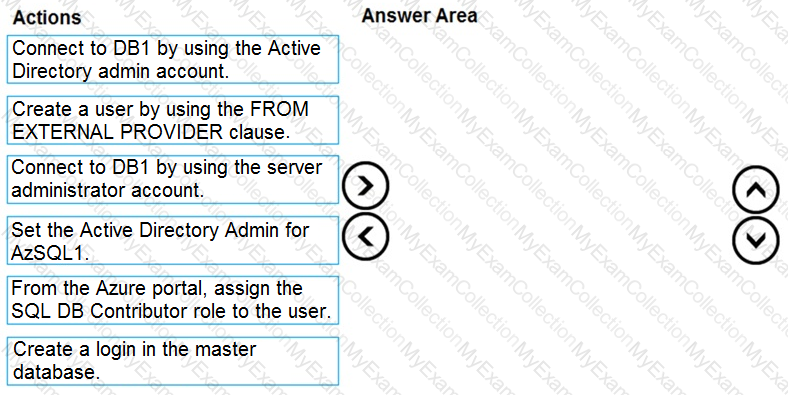
You have 50 Azure SQL databases.
You need to notify the database owner when the database settings, such as the database size and pricing tier, are modified in Azure.
What should you do?
You have an Azure subscription that contains two Azure SQL managed instances named SQLMI1 and SQLMI2 . SQLM2 contains a database named DB1 and a user named User1.
User1 drops DB1.
You need to perform a point-in-time restore of DB1 to SQLMI2.
Note: This question is part of a series of questions that present the same scenario. Each question in the series contains a unique solution that might meet the stated goals. Some question sets might have more than one correct solution, while others might not have a correct solution.
After you answer a question in this section, you will NOT be able to return to it. As a result, these questions will not appear in the review screen.
You have an Azure Synapse Analytics dedicated SQL pool that contains a table named Table1.
You have files that are ingested and loaded into an Azure Data Lake Storage Gen2 container named container1.
You plan to insert data from the files into Table1 and transform the data. Each row of data in the files will produce one row in the serving layer of Table1.
You need to ensure that when the source data files are loaded to container1, the DateTime is stored as an additional column in Table1.
Solution: In an Azure Synapse Analytics pipeline, you use a Get Metadata activity that retrieves the DateTime of the files.
Does this meet the goal?
You have an Azure SQL database named DB1. DB1 has a table named Table1 that contains the following columns.
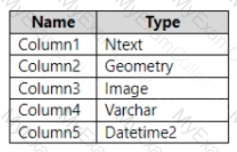
You plan to enable Always Encrypted for Table1.
Which two columns support encryption? Each correct answer presents a complete solution.
NOTE: Each correct selection is worth one point
You are designing a streaming data solution that will ingest variable volumes of data.
You need to ensure that you can change the partition count after creation.
Which service should you use to ingest the data?
Note: This question is part of a series of questions that present the same scenario. Each question in the series contains a unique solution that might meet the stated goals. Some question sets might have more than one correct solution, while others might not have a correct solution.
After you answer a question in this section, you will NOT be able to return to it. As a result, these questions will not appear in the review screen.
You have an Azure Synapse Analytics dedicated SQL pool that contains a table named Table1.
You have files that are ingested and loaded into an Azure Data Lake Storage Gen2 container named container1.
You plan to insert data from the files into Table1 and transform the data. Each row of data in the files will produce one row in the serving layer of Table1.
You need to ensure that when the source data files are loaded to container1, the DateTime is stored as an additional column in Table1.
Solution: You use an Azure Synapse Analytics serverless SQL pool to create an external table that has an additional DateTime column.
Does this meet the goal?
You have two on-premises Microsoft SQL Server instances named SQL1 and SQL2.
You have an Azure subscription
You need to sync a subset of tables between the databases hosted on SQL1 and SQL2 by using SQL Data Sync.
Which five actions should you perform in sequence' To answer, move the appropriate actions from the list of actions to the answer area and arrange them in the correct order.

You have an Azure subscription.
You plan to migrate 10 on-premises Microsoft SQL Server instances to Azure.
You need to ensure that the migrated environment can be managed by using multiserver administration and supports master/target (MSX/TSX) jobs. The solution must minimize administrative effort.
Which SQL deployment options should you select as the master server (MSX) and the target server (TSX)? To answer, select the appropriate options in the answer area.
NOTE: Each correct selection is worth one point.
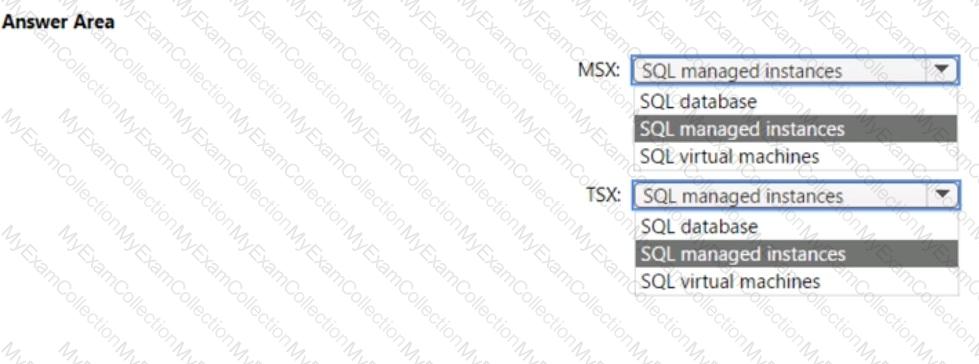
You plan to develop a dataset named Purchases by using Azure Databricks. Purchases will contain the following columns:
ProductID
ItemPrice
LineTotal
Quantity
StoreID
Minute
Month
Hour
Year
Day
You need to store the data to support hourly incremental load pipelines that will vary for each StoreID. The solution must minimize storage costs.
How should you complete the code? To answer, select the appropriate options in the answer area.
NOTE: Each correct selection is worth one point.
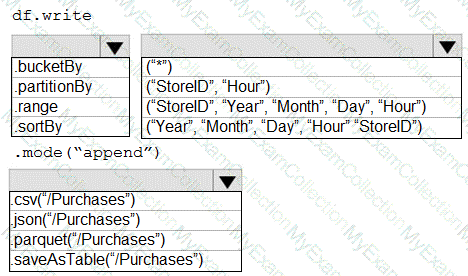
You need to identify the cause of the performance issues on SalesSQLDb1.
Which two dynamic management views should you use? Each correct answer presents part of the solution.
NOTE: Each correct selection is worth one point.
You need to recommend the appropriate purchasing model and deployment option for the 30 new databases. The solution must meet the technical requirements and the business requirements.
What should you recommend? To answer, select the appropriate options in the answer area.
NOTE: Each correct selection is worth one point.
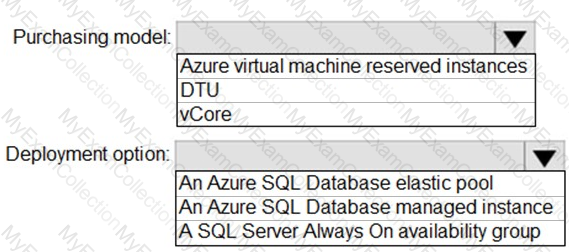
You are evaluating the business goals.
Which feature should you use to provide customers with the required level of access based on their service agreement?
You need to implement authentication for ResearchDB1. The solution must meet the security and compliance requirements.
What should you run as part of the implementation?

